
Lamb al asador is a classic Patagonian method of barbecue with a whole lamb flayed and hung on an asado cross over an open fire. I had the good fortune to be able to eat lamb al asador in Chile in early 2020 (pre lockdown!). The cook is nice and long, giving plenty of time for smoke and the salmuera (a basted brine) to suffuse the meat producing a sublime, tender end result. I enjoyed it so much that I have been very keen to try my hand at cooking al asador ever since.
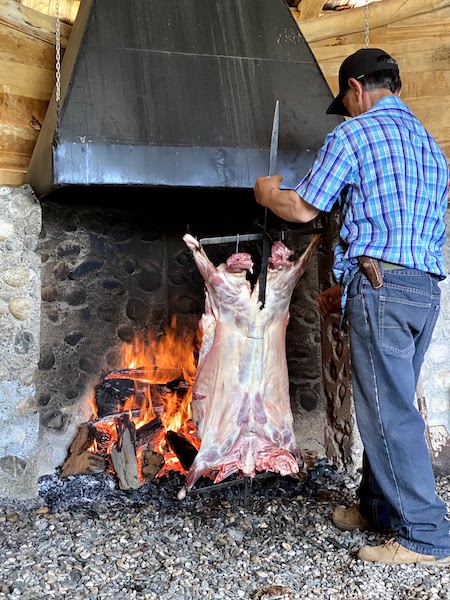
Following last year’s epic kalua pork, Richard generously offered to host us in Kenwood, CA again to realize that al asador dream. He is a metalworking wizard and made the asado crosses we used himself. My good friends Johan, Nav and Luca joined me to cook this feast for ~60 friends old and new.
The asado cross
An asado cross, is a traditional tool used in Argentinian and other South American styles of barbecue. Essentially, it’s a large cross made from metal (usually iron or steel), used to secure and roast a whole animal, such as a pig or lamb, over an open fire.
The cross consists of a long vertical post with two shorter crossbars at the top and bottom. The meat is splayed open and securely tied to the cross. The whole setup is then leaned at an angle over the fire, allowing for slow, indirect cooking from the radiant heat of the embers.
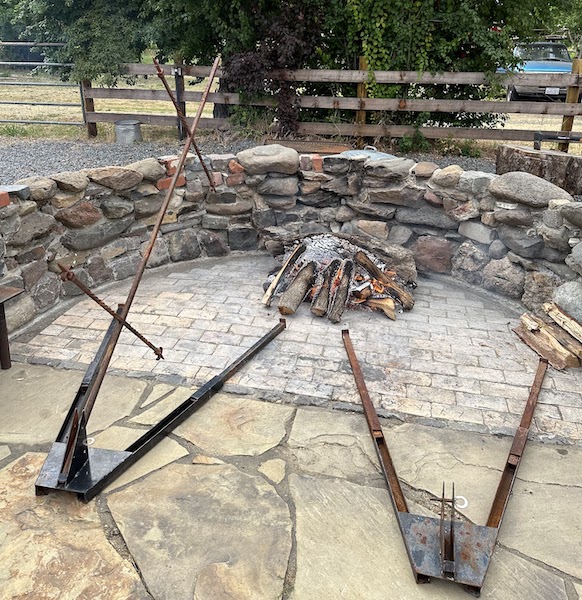
Richard’s crosses are quite ingenious. They feature an adjustable pitch base for the crosses to sit in and the main upright of each cross is made of box section. They are therefore easy to rotate mid-cook (great for basting) and stable with the carcass facing either direction. You may not find a cross quite like these ones, but lots of folks make them to sell online via Etsy, ship from Argentina etc.
The lamb
The ideal size of lamb for this cook is a fairly small one: 40 - 50 lbs. Typically, the ratio of pre-cooked to edible meat is 50%. A rule of thumb is to plan on a third to a half a pound of meat per person, so a 40 lb lamb will feed 40 - 60 people. The lamb needs to be butterflied so that it lays open on its back, which is done by using a hatchet or saw to cut through sternum and along the backbone as well as breaking the shoulder joints. We had our butcher do this for us. If you need to do it yourself there are a few videos showing how on YouTube.
Securing the lamb
Attaching the lamb to the cross is a critical step, requiring careful positioning and secure fastening. The idea is to ensure even heat distribution and prevent the meat from slipping during the long hours of cooking.
- Position the lamb on the cross: Lay the cross flat on the ground or a table, then position the butterflied lamb onto the cross, open side up. The cross bars should align with the front and back legs of the animal.
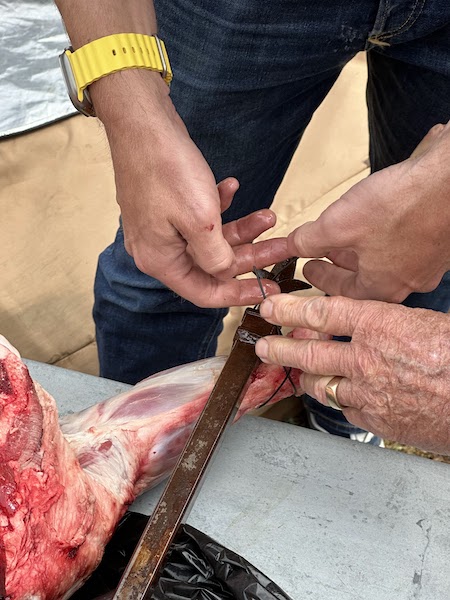
- Secure the lamb: The lamb is securely fastened to the cross using stainless steel wire. It’s important to fasten it at the end of each leg and at several points along the backbone to ensure stability. Start by securing the legs to the cross bars. Then attach the lamb’s back and neck to the cross’s long post. You’ll need to poke holes through the neck and around the backbone. Make sure it’s tightly fastened so it won’t shift or sag during cooking.
-
Season, and score the back of the lamb: Liberally season the meat inside and out with salt. To help the fat on the lamb’s back crisp up at the end of cooking and to just make it look great, score the back of the lamb in a diamond pattern across the whole length. We also stuffed some sprigs of rosemary into the scored diamonds at regular intervals.
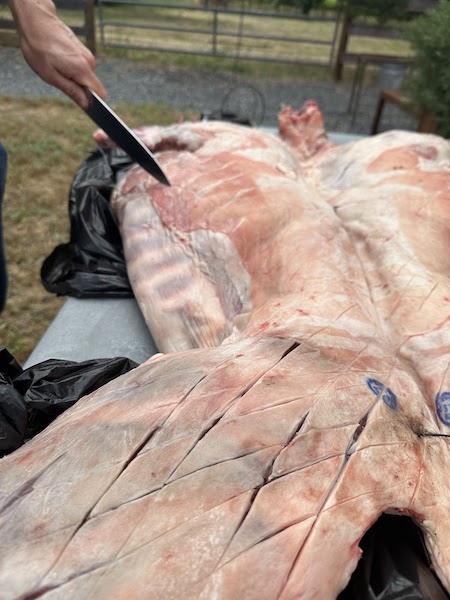
-
Check stability: Before you start cooking, lift the cross and give it a gentle shake to make sure the lamb is secure. If there’s any movement, you’ll need to tighten the ties or add more.
-
Set up the cross: Finally, the cross is set up over the fire at an angle to allow for indirect cooking from the heat of the embers. Initially (and for the vast majority of the cooking time) the inside of the lamb faces the heat.
The fire

Building the right fire is essential for al asador cooking. It’s not just about creating flames, but controlling the heat and maintaining a consistent temperature throughout the long cooking process. The fuel you use can significantly impact the flavor of the meat. Hardwoods like oak, hickory, or fruit woods are great choices as they burn slowly and steadily, providing consistent heat. Start by building a large fire in your fire pit. Arrange your chosen wood so there is plenty of airflow between the logs. Start with smaller, easily ignited pieces to get the fire going, and then gradually add larger logs. The goal is to create a substantial bed of embers that will provide consistent, indirect heat.
Managing the Fire: Throughout the cooking process, keep adding logs to the fire to maintain a steady bed of embers. Cooking al asador is a slow process. Have some fun while the lamb cooks, but it’s important not to forget to keep stoking the fire. Here’s a tip I learned from Richard: find a funky hat. That’s the fire hat. Whoever is wearing it is responsible for keeping the fire in great shape.
Regulating the Heat: The distance between the lamb and the embers will regulate the cooking temperature. If the lamb is cooking too fast or charring, raise the cross further from the embers. If it’s cooking too slowly, you can lower the cross to bring it closer to the heat source. Alternatively, once you have a good bed of embers, you can move some of them directly under the area where the lamb is be positioned to speed up the rate of cooking. The lamb should not be directly over the flames. The heat from the embers is what will cook the lamb slowly and thoroughly. When adjusting the heat correctly, you should be able to hold your hand next to the lamb, at the same distance from the fire, for about 15 seconds before it starts to feel at all uncomfortable.
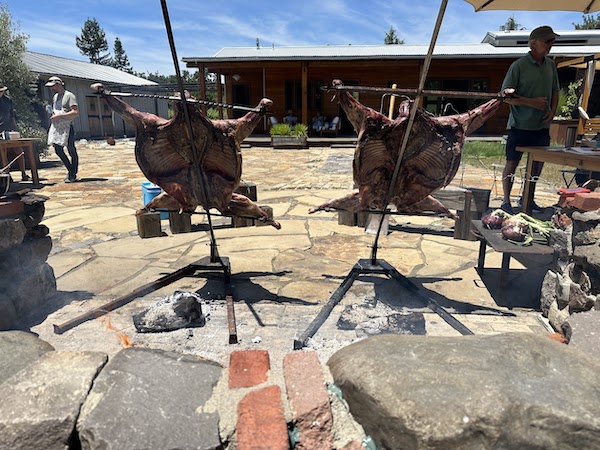
Maintaining Safety: Always keep safety top of mind. Use fire gloves and safe fire handling tools (e.g., a shovel) for moving logs or adjusting the asado cross.
Salmuera
Salmuera, a salty brine, gives the meat its unique flavor profile and keeps it juicy through the long cook. It’s prepared by simmering water, salt, garlic, and lemon together until well infused. Regular basting of the lamb with this concoction is essential throughout the cooking process to maintain moisture and add flavor.
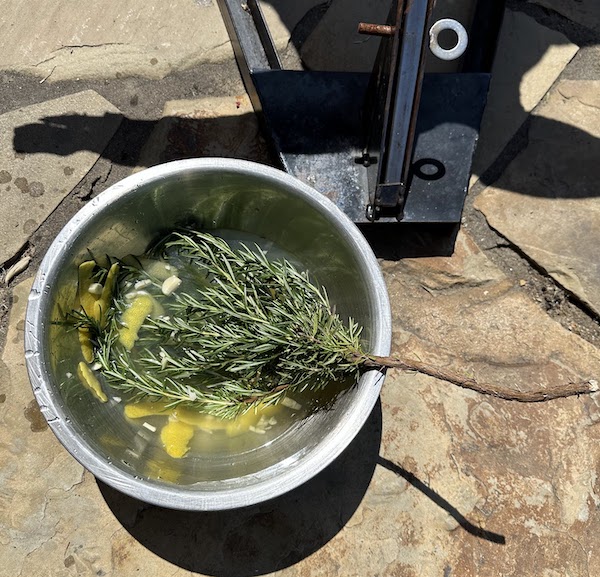
Ingredients
- 4 cups water
- 1/3 cup salt
- juice and peels of 4 lemons
- 5 cloves garlic, sliced.
We basted every 20-30 mins using a rosemary brush, also allowed to infuse in the brine.
J Kenji López-Alt inspired aside: The salt and water in the Salmuera is really what’s key. It’s mostly about keeping the lamb moist and infusing the salt in the meat. As well as the traditional Salmuera recipe, we tried a more heavily spiced brine on one lamb and it made no tangible difference to the final taste. If you want to flavor the meat with spices (not the traditional method) you’ll need to do so prior to cook.
The cook goes on
The key to perfect al asador lamb is patience. Aiming for an internal temperature of about 145°F will ensure well-cooked, tender meat. It’s crucial to maintain a steady fire, occasionally pulling some coals directly under the meat to manage heat. Toward the end of the cooking process (final 30 mins or so), the lamb is flipped so that beautifully scored back fat faces the fire. This allows the fat to crisp up under the heat.
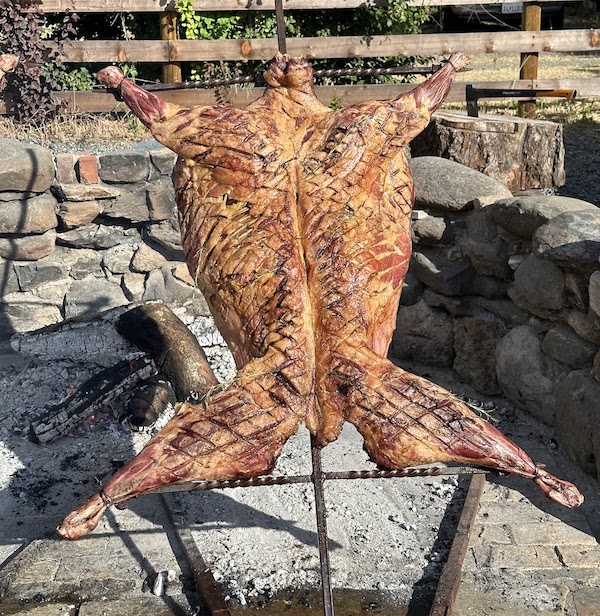
To test if the lamb is ready the Patagonian way, a slice can be taken from a thicker part. If the inside is tender and well cooked, then it’s time to call everyone to the table (also check the center has reached 145°F with an instant read thermometer 😉).
Accompaniments
A lamb this delicious needs only simple accompaniments. We opted for pita bread, providing a soft, chewy foil for the tender, smoky meat. Sweet potatoes and onions roasted directly in the embers of the fire were quite a treat. We also prepared several homemade chimichurri sauces, an Argentinian classic that perfectly complements the lamb’s flavor with its tangy freshness. Finally, a variety of salads rounded out the feast.
Timing
Here’s the schedule we used to cook the two lambs pictured above, which were both on the large side (55 lbs each). Smaller will cook faster. A 40 lb animal could have been ready in 4-5 hrs vs 6, though you can of course regulate the temperatire and long and slow is good. Critically our lamb was cooked but incredibly juicy when tested so did not start drying out as it would if overcooked.
Lamb: (For readiness at 5 pm)
- 10 am - start fire
- 10:30 am - truss the lamb, attach to iron cross, liberally season with salt and set in the ground 6-9 feet away for medium-low heat
- 11 am - Start the cooking, adjusting the heat as needed by leaning the cross towards/away from the flame
- every 20-30 mins - sprinkle outside of lamb with salmuera, turn so the bone is away from the fire. Perhaps rake some coals from fire just under the lamb to make sure the skin side crisps and cooks evenly.
- 4pm - cook vegetables in the embers, turn back of lamb to the fire.
- 5pm - test doneness by cutting off a slice, should be nice and crispy, internal temp ~145F. Let rest for 10-20min and serve.
Serving
Serving lamb al asador is a festive moment. Once the meat has rested for about 15 minutes to allow the juices to redistribute, the lamb can be carved directly from the cross. Everyone gets to choose their preferred cuts, from succulent rib meat to crispy edges.
Conclusion
Cooking lamb al asador goes beyond preparing a meal; it’s about creating an experience. The slow process, the communal nature of the feast, and the sheer joy of eating meat cooked to perfection over an open fire makes it an unforgettable adventure.
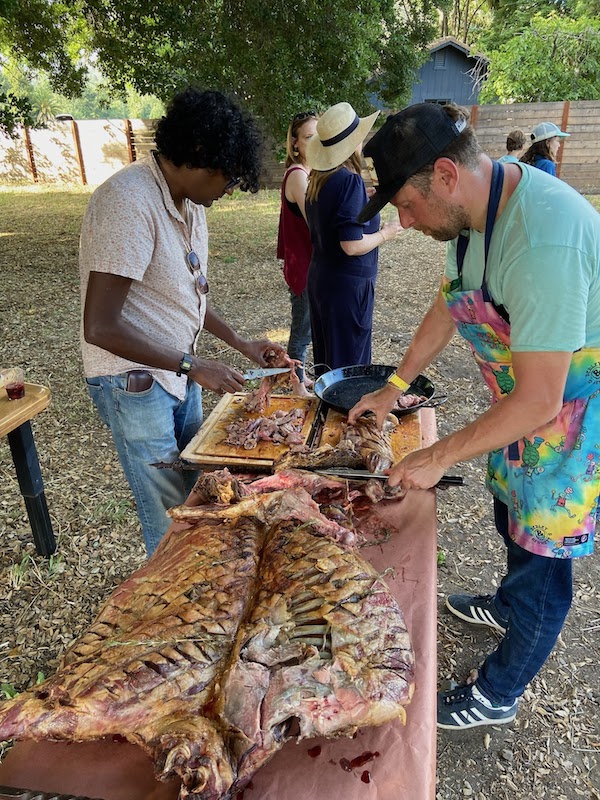
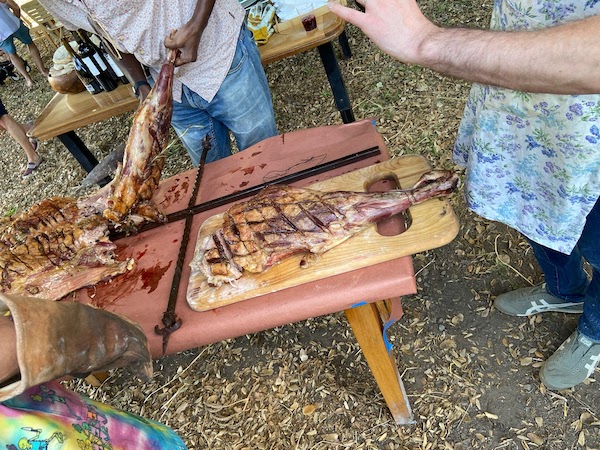
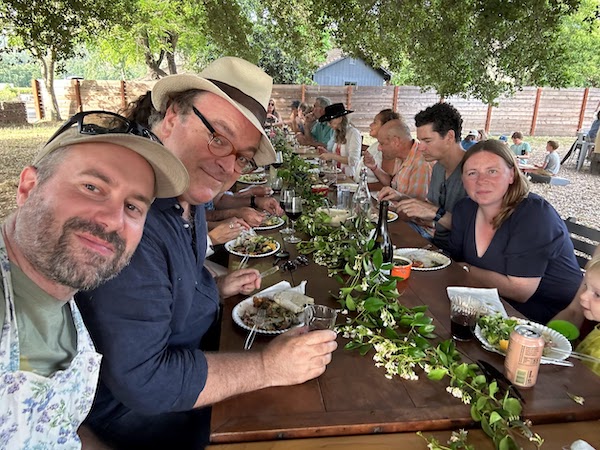
Leftovers
If you have leftovers, check out my mother’s inimitable Irish stew - the lamb cuts for this are usually quite tricky to get hold of in the US so it’s a real treat!